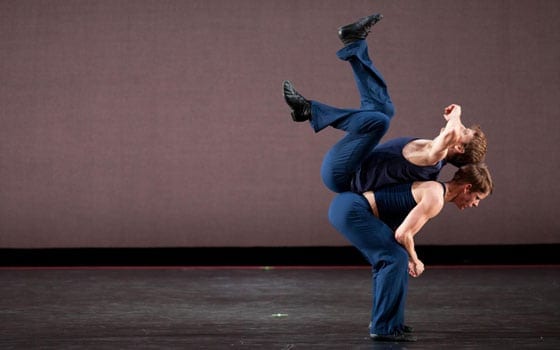
As a dancer and choreographer, Bill T. Jones finds the material of his artistry in the human body as it suffers, ages, loves, exults, labors and struggles — alone and with others.
The expressive power of the body propels his productions, including Broadway ventures such as “FELA!” which received the 2010 Tony Award for Best Choreography, and soon, “Super Fly” re-imagined as a musical.
The body in all its manifestations is the implicit subject of the works he creates as choreographer and artistic director of the Bill T. Jones/Arnie Zane Dance Company, which he founded in 1982 with his partner in dance and life, the late Arnie T. Zane. Recipient of a 1994 MacArthur Fellowship, Jones has developed the company’s ambitious, evening-length collaborations with other artists that explore such themes as mortality, faith and racism in America.
Forty years ago, as young dancers and choreographers in New York City, Jones and Zane pared dancing down to the drama of body against body in their muscular, athletic duos. Repeating a series of seemingly ordinary movements with subtle variations and laced by quirky gestures, their dances were intimate games. Unadorned visual poems that evoked human striving and connection, the duos between the wiry 5’4” Jewish-Italian Zane and 6’1” African American Jones became landmarks of contemporary dance.
The artistry of Jones and Zane was on display in its purest form this weekend at the Institute of Contemporary Art/Boston (ICA) in three sold-out shows. In a world premiere program aptly entitled “Body Against Body,” the Bill T. Jones/Arnie Zane Dance Company recreated three of the pair’s groundbreaking duets.
Guided by the company’s rehearsal director Janet Wong, with costumes by Liz Prince, lighting by Robert Wierzel and music by Helen Thorington and John Oswald — all long-time collaborators of Jones — and performed by the company’s terrific dancers, the two-hour program affirmed the timeless power of these early works.
Translating dances that originated as a dialogue between lovers into works that stand on their own, the new versions were far more than a look back.
As part of the presentation, the ICA also inaugurated its fine new dance education program, “MAKE DANCE SEE.” Events included the company’s five-day residency at the Boston Arts Academy and pre-performance dance workshops for audience members as well as a panel discussion with Jones and the choreographers Karole Armitage and Elizabeth Streb.
The program opened and concluded with a Jones/Zane duet named for places north of New York City where the partners began their life together.
The evening began with “Monkey Run Road” (1979), staged here for the first time since Zane and Jones performed it more than two decades ago. Evoking the physical contrast between the original partners, the dancers were Talli Jackson, a tall, mixed-race man and Erick Montes, a Mexican of small stature.
Their differences contributed to the work’s subtle dynamism and touch of humor. In black jumpsuits that resembled work attire, the two men went about doing things that didn’t make much sense with great care. Light followed them as they repeatedly pushed a tub-size wooden crate around the darkened stage, paused, and arranged themselves into a pose. In one, Jackson looked down on Montes, who stared straight ahead. In another, they resembled a Pietà painting, with the supine Montes on Jackson’s lap. Their brief reunions suggested moments of equipoise in a relationship.
Their repetitive routine called to mind the interplay of Samuel Beckett’s two tramps in “Waiting for Godot,” who carry on in their bleak landscape with volleys of language. Here, the two exchanged riffs of movement, performing seemingly ordinary gestures with extraordinary grace and control. Jackson often rose into an elegant vertical figure, encompassing his long body with curving arms. Montes, wiry and quick, darted and sprang at an angle to his partner. Then the two came together, holding a pose. The dancers occasionally spoke. Montes addressed the audience briefly in his native Spanish. Jackson called out place names, such as Paris.
The evening concluded with “Blauvelt Mountain” (1980). The partners jointly choreographed the work, which Jones revised in 2002. Instead of two men, the dancers were Paul Matteson and his equally athletic female partner, Jennifer Nugent, whose cropped hair and muscular upper body gave her an androgynous appearance.
Both wore blue leotards, and in an absorbing opening scene, they echoed each other in slow, floor-hugging crawls before unrolling their bodies to begin a tension-packed series of encounters. Within a rubric of rapid-fire ritual movements, they alternatively coaxed and challenged each other, at one point tossing one another their sole props, a set of chairs. The two also traded a few volleys of words. In a tersely poetic closing, Matteson shouted “home” and Nugent responded, “world.”
Between the two duets, the company performed its thrilling reinvention of “Continuous Replay” (1978), with wondrous live sound by John Oswald. Originally choreographed by Jones as a duet and transformed here to engage the entire ensemble, the electrifying production started with a jolt and never let up.
With poker-faced dignity, a naked Peter Chamberlin stepped into the light and began to mechanically repeat a series of absurd gestures, using his hand to form a bird-like shape, tilting his head to the side, and releasing an animal-like squawk. Meanwhile, other dancers, also nude, ran across the stage behind him and then joined him in a growing band, each repeating the same gestures and squawks.
Oswald’s soundscape varied from lone bird cries to a cacophony worthy of an entire colony while weaving in snatches of romantic melody and moments of silence that heightened attention on the dancers.
Like a gospel choir, members of the group moved in unison while others leapt in improvisational fervor. Meanwhile, in a pool of light, a series of soloists costumed in black and white danced in slow counterpoint to the group’s rhythmic momentum. As ritual became a unifying force, the repetitive gestures spreading like a kind of DNA, the majestic performance turned into a celebration of survival.






